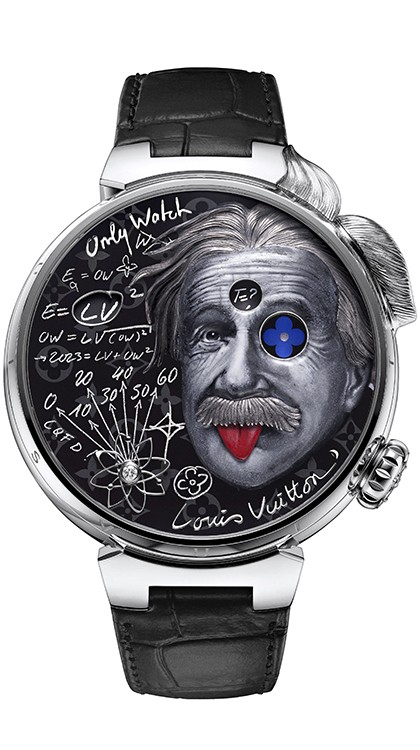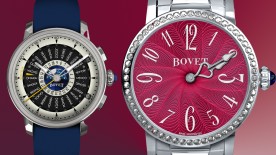1. TAG Heuer Monaco Split-Seconds Chronograph
The new leadership at TAG Heuer is certainly causing a stir. Following the resounding global success of the new Carreras, Carole Kasapi’s team, under Frédéric Arnault’s guidance, returned to the workbench to create the first split-second chronograph in the company’s recent history. The complication isn’t new; TAG Heuer has been working with chronographs for more than a century. But they have seldom appeared on more recent models. You have to go back to the 1960s to find mechanical split-second calibres, and 1989 for their quartz equivalent.
This timepiece boasts numerous unique characteristics, starting with a disruptive aesthetic, a carved sapphire case back into which the movement nestles, and unusually textured titanium. And then there’s a new movement, the TH81-00, developed in collaboration with Vaucher, that can measure two separate times simultaneously. Plus, it’s the lightest automatic chronograph movement TAG Heuer has ever made, crafted entirely from titanium.
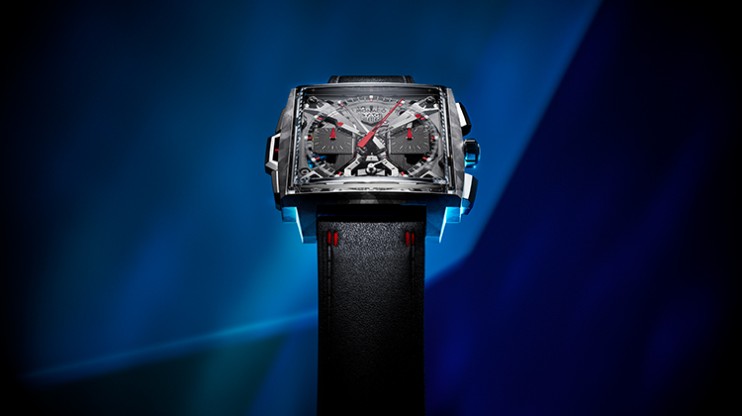
2. Jacob & Co. and Concepto Watch Factory – Astronomia Revolution 4th Dimension
Where to begin? This “fourth dimension” is so extraordinary that it’s almost impossible to describe! It features a three-axis flying tourbillon at one end of a two-arm carousel, with the other end holding the time module. The first axis of the tourbillon completes a revolution in 60 seconds, the second in 18 seconds, and the last in 15 seconds, all on the end of a rotating arm. This makes it a four-axis tourbillon, a first in wristwatch history.
Moreover, the tourbillon cage houses a constant-force escapement. The dial beneath the rotating carousel is a masterfully hollowed-out rose gold structure, reminiscent of a high jewellery piece. Jacob & Co. has embellished it with 35 precious stones chosen from 7 varieties of gems, all individually cut to create a kaleidoscope of coloured light. Each gem is set facing upwards in a random arrangement, creating an uneven surface that catches the light, transforms it and reflects it back, all within an unapologetically extravagant 47 mm case.
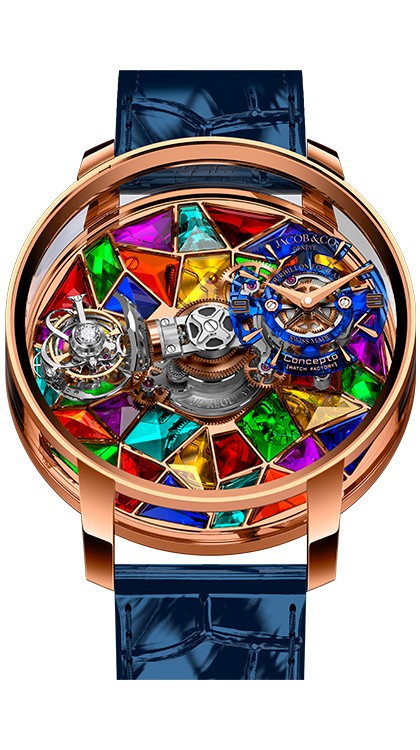
3. Konstantin Chaykin Stargazer
Konstantin Chaykin is an independent watchmaker who set up his own manufacture in 2003. He’s among the most prolific inventors, recently gaining significant exposure for his Joker, whose distinctive aesthetic was a massive hit. But for Only Watch, he has returned to the realm of grand complications.
Konstantin Chaykin has crafted a watch crammed full of complications. The Stargazer, built around the Joker’s design, showcases a total of 16 complications, including a tourbillon and 11 astronomical functions. The watch features a reversible double face, a symmetrical case, H-shaped lugs and a reversible strap with a unique fastening system and even a reversible buckle.
The Stargazer has two dials, enabling it to display numerous indications without compromising legibility. Some complications are unprecedented in the annals of watchmaking: a subtle moon phase indicator and azimuth indicators for sunrise and sunset – both patented innovations. All this brilliance is packed into a mere 42 mm diameter. It’s an astounding feat from a prolific, ingenious, brilliant and yet unassuming watchmaker.
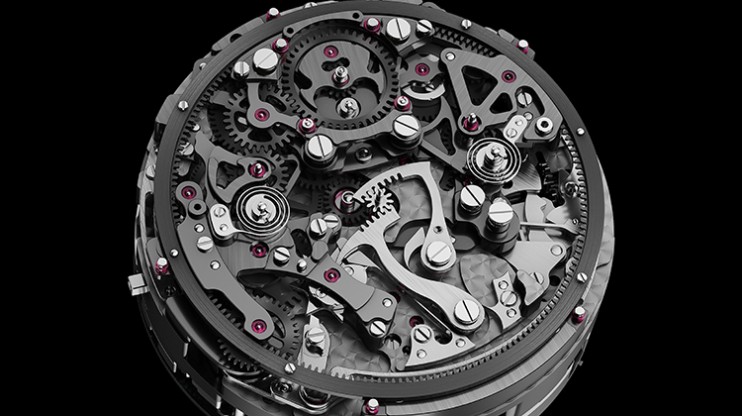
4. L. Leroy Minute Repeater
While the 2023 edition of Only Watch is teeming with tourbillons, minute repeaters are surprisingly scarce. This one from L. Leroy is all the more unexpected, given that the brand seemed to be virtually dormant – a sad situation given that this historic name, a contemporary of Berthoud, Breguet, Moinet and many others, possesses a legacy of horological marvels that still grace palaces and castles around Europe.
L. Leroy has created a one-of-a-kind piece inspired by a tactile pendant watch (“montre à tact”) made by Leroy around 1810 for Prince Emil Maximilian Leopold of Hesse. In those days, given that there was no electricity, and luminous hands were yet to be invented, this watch allowed the time to be read even in the dark, by feeling the hand as it moved over the twelve diamonds that marked the hours on the case’s edge.
Today, L. Leroy has reimagined this historic timepiece, now in the collection of the Patek Philippe Museum. Its manually wound movement features a flying tourbillon and a minute repeater. The 43 mm case is crafted from two metals: the middle, case back, chime lock and crown are in grade 5 titanium, while the bezel and back cover are in 18-karat white gold Palladium PD210. It took 120 hours to engrave entirely by hand – not surprising given the incredible hardness of titanium.
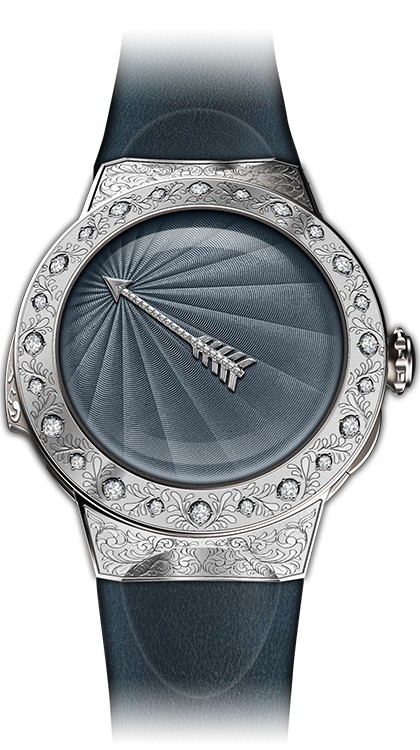
5. Louis Vuitton Tambour Einstein Automaton
La Fabrique du Temps Louis Vuitton is equally revered and reviled for its trademark approach: defying convention. The Albert Einstein automaton continues this tradition. The scientist’s left eye is replaced with a Louis Vuitton Monogram Flower in blue lacquer, situated above his iconic pink tongue. The left half of the dial is covered with equations. One of them, “E = LV2”, is a playful homage to his renowned mass-energy equivalence formula “E = MC2”. At the base of the dial is a model of an atom encircled by four valence orbitals. An aperture on Einstein’s forehead reveals the unsolved equation “T = ?”.
A lock of hair conceals the activation button for the automaton, which triggers four animations. The pattern in the forehead opening transforms into a number from 1 to 12, indicating the hour. The atom then begins to rotate: one of its valence orbitals (identifiable by its pointed lacquered tip) moves until it reaches the correct position on a scale from 0 to 60, thereby revealing the minutes. The petals of the Monogram Flower in Einstein’s eye retract, revealing the movement’s mechanical heart. Lastly, his tongue protrudes. The watch holds one final secret: when the power reserve is nearly depleted, E will no longer be equal to LV2, but to OW2 – the initials of the Only Watch charity auction.
